The 2018-19 season has come and gone for the Nashville Predators. An up-and-down regular season may have ended with a Central Division title, but the season ultimately concluded with a first-round exit at the hands of the Dallas Stars. An obvious letdown given the team’s roster makeup and success in recent seasons, it’s time to review the 2018-19 season, including player performances.
Related: Predators’ First-Round Exit a Long Time Coming
I begin this review by covering the Predators’ forwards and grading them on how they played in 2018-19. I’ll discuss what made their season a success or a failure, and propose the biggest question surrounding that player entering 2019-20 before ultimately giving his season a grade.
Ryan Johansen
Johansen, the team’s first-line center, led the Predators with 64 points in 80 games. His 64 points are the second-highest of his career and his 50 assists set a career-high. Averaging 19:33 per game, he set a career-high and it was only his second time averaging more than 19 minutes per game. He was strong in the faceoff circle, at 53.5 percent, but did have a minus-17 turnover margin, the worst of his career. He’s continuing to develop into one of the game’s better playmaking centers as evident by his 50 assists.

Question(s): (1) Can he take the next step and become a top-15 or even top-10 center? He ranked 18th in assists among centers and tied for 37th in points; and (2) Will head coach Peter Laviolette play Johansen enough to climb to that next level?
Grade: A | Johansen drives the Predators’ top line and played a portion of the season without either of his wingers. He’s strong in all three zones, plays on both the power play and penalty kill and has been everything the Predators could have hoped for when they acquired him from the Columbus Blue Jackets.
Filip Forsberg
The good: Forsberg’s 28 goals were second on the team and represented a bounceback (26 goals in 2017-18). He’s also a great two-way forward who plays in all situations and could be a dark-horse Selke Trophy candidate in the future. The bad: His 50 points were his fewest since before he became a full-time NHLer in 2014-15. His shooting percentage regressed nearly two points compared to 2017-18 and he missed 18 games. Furthermore, he struggled after returning from injury with only 14 goals and 28 points in 38 games versus 14 goals and 22 points in 22 games before the injury. Was this the result of his injury? He also looked disinterested at times during the regular season.
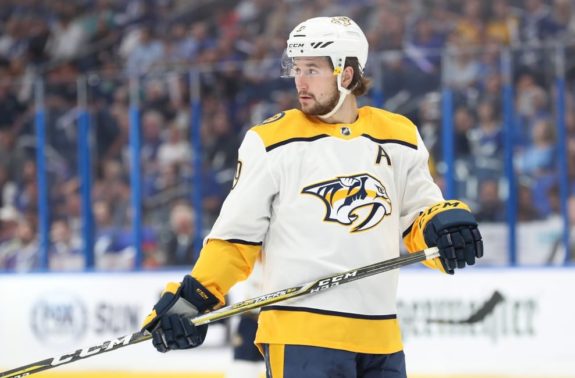
Question(s): Can he become the elite, consistent scorer the Predators need him to be? The Stars’ ability to limit him hurt the Predators during the playoffs and he needs to fight through this for the team to be a Stanley Cup threat.
Grade: B | Another consistent season from Forsberg, but his development stagnated. His two-way play is great, but his best skillset is producing offensively, and he needs to be more consistent in showing that skillset.
Viktor Arvidsson
Arvidsson missed 24 games but still managed to score 34 goals, breaking the franchise record by one and his personal best by three. He finished third in the league in goals-per-game and his 29 even-strength goals tied for ninth. He was the Predators’ only consistent goalscorer, although he did shoot a career-high 17.4 percent.
Question(s): With a shooting percentage that could regress (12.2 percent for his career), is Arvidsson’s 2018-19 season sustainable? And if it is, could he become a 40-goal scorer, especially if the team’s power play rebounds?
Grade: A+ | All that Arvidsson did was set a franchise record with 34 goals…in 58 games. His speed gave opponents fits and his shot gave goaltenders trouble regardless of where he attempted it from. Oh, and the fact that 29 of his goals occurred at even strength means there’s potential for sustainability.
Craig Smith
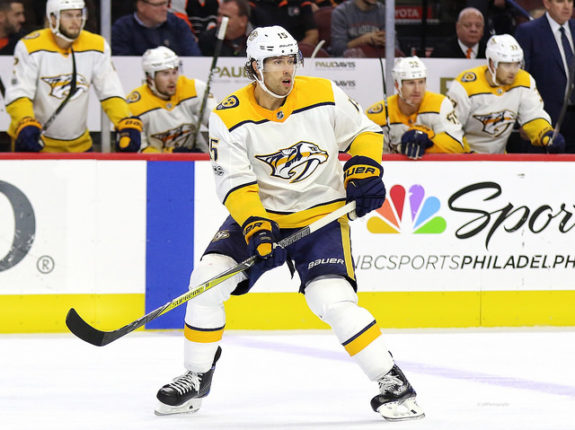
Smith regarded his fifth 20-goal season, although his 21 goals were a regression from the 25 he scored in 2017-18. He also only totaled 17 assists and four power-play goals. It was basically an average season for him: his shooting percentage and time on ice were both in line with career norms. The only area he wasn’t in line with his career average was assists, but that could have as much to do with linemates not scoring as it does with him struggling. Smith is a known commodity, but he does have a low ceiling. He’ll turn 30 before next season, and at this point in his career, he is what he is.
Question(s): As a free agent in 2020, what is Smith’s future in Nashville? Could he be dealt this offseason in an effort to shed some salary.
Grade: C | Smith is an average middle-six winger who had an average season. A ‘C’ is an average grade.
Nick Bonino
Bonino is the Predators’ third-line center and players in that role aren’t expected to produce much. However, someone didn’t tell him that. In his age-30 season, his 17 goals were the second-most of his career and his 35 points were fourth-most. He also won 51.8 percent of draws. While his stats don’t approach the ones he had with the Pittsburgh Penguins, he also wasn’t playing with Carl Hagelin and Phil Kessel in Nashville.
With lackluster linemates, Bonino consistently produced, including on the man advantage where he had three goals. The only negative to his season was that he had a negative turnover differential for the first time in his career; however, he made up for it with the most defensive point shares of his career.
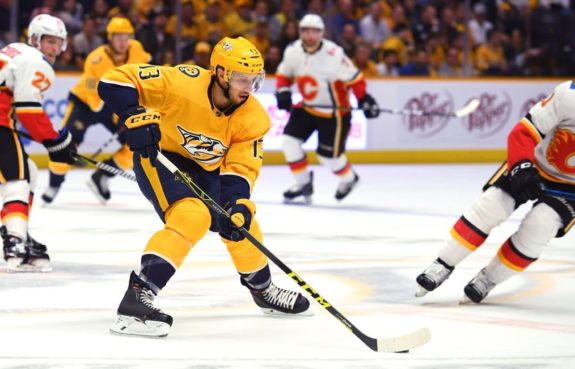
Question(s): There really are no questions regarding Bonino. The only one I can think of is can general manager David Poile get Bonino some talented linemates and give the Predators a scoring threat on the third line?
Grade: B | Bonino knows his role and plays it well.
Colton Sissons
Sissons’ goal and point totals have increased every season in the league to the 15 goals and 30 points he had in 2018-19. He also finished with a plus-10 turnover margin and his shooting percentage (13.6) wasn’t even a career-high. He brought consistent production despite bouncing around all four lines and he tied for fifth on the team in goals despite being the lowest paid player. That made him the Predators’ most valuable player.
Question(s): As a restricted free agent this summer, what does Sissons’ next contract look like? And if he received more playing time, could he see a further increase in production?
Grade: A+ | With a $625,000 cap hit, Sissons finished ahead of 16 Predators in points, all with higher cap hits. He emerged as a forward capable of playing in every situation.
Calle Järnkrok
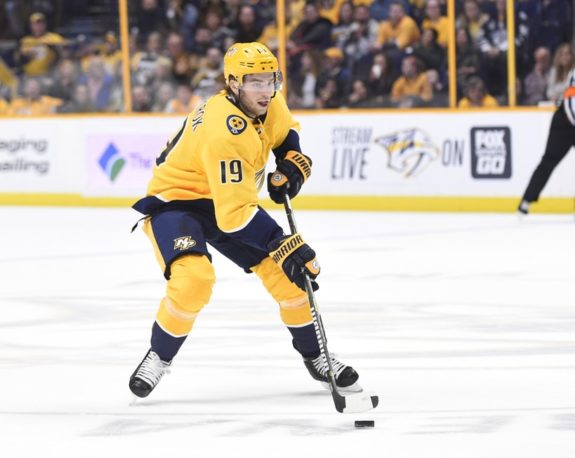
Järnkrok had his lowest goal-per-game and point-per-game rates since 2014-15, his first full season in the NHL. His shooting percentage (9.4) was the second-lowest of his career. This season represented a major regression in nearly all categories after improving every season through 2017-18. He still managed to have a positive turnover margin, but considering he’ll turn 28 before the 2019-20 regular season begins, Järnkrok is reaching a turning point in his career.
Question(s): What type of player is Järnkrok long-term? Is he a middle-six forward? Does he have second line upside? Can he bounceback after a bad 2018-19?
Grade: C- | Järnkrok was expected to take another step and potentially be an option for the second line. He failed to do so and regressed in a big way.
Kyle Turris
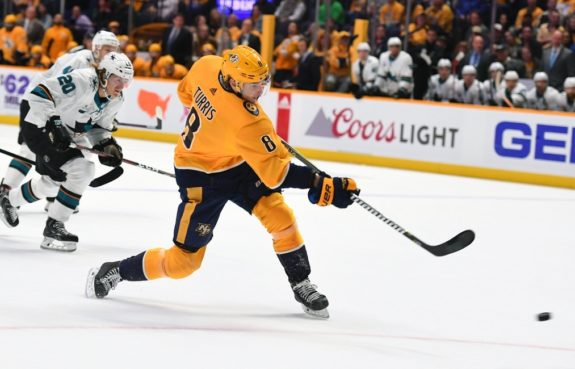
There really isn’t much to say about Turris’ tenure is Nashville that hasn’t already been said. In 2018-19, he missed 27 games and his seven goals were his fewest since 2007-08 when he played three games, while his 23 points were his lowest mark since his first full season in 2008-09. He shot just nine percent, third-lowest of his career and he attempted his fewest shots-per-game. Of the 16 NHL forwards with a $6 million cap hit in 2018-19, Turris finished 14th in points and tied for 261st among all forwards. None of what I just wrote is reflective of a player expected to be a second-line center.
Question(s): Is there any chance of a bounceback after a second straight season of regression? Is there any scenario in which he’s not trade over the offseason?
Grade: F | The Predators parted with a second-round pick and two prospects for Turris and gave him a six-year, $36-million contract and he’s been a bust ever since. He was the main reason the Predators didn’t have a second scoring line.
Austin Watson
Watson only played in 37 games due to two suspensions, one for domestic abuse and the other for alcohol abuse. When he played, though, he was great with seven goals and 16 points in a bottom-six role. He set career-highs in goals-per-game, points-per-game, shots-per-game and time on ice. He also cut down the number of penalties he took per game. He also managed to produce without riding an elevated shooting percentage.
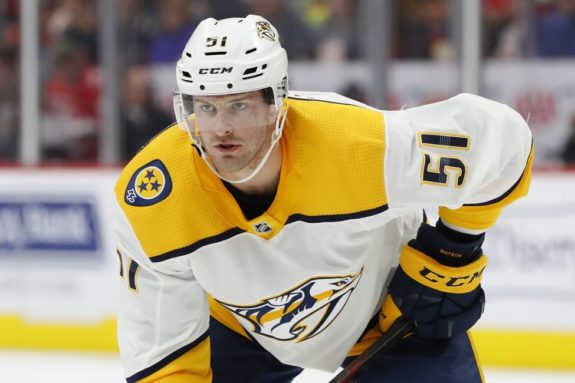
Question(s): What does a full season look like from him if he stays on the ice? Could he become a cheap man’s Matthew Tkachuk or Tom Wilson? How many more chances does Watson get from the Predators?
Grade: C+ | Watson won’t be a top-six forward, but he proved in 2018-19 that he can produce and showed why the Predators spent a first-round pick on him in 2010. If he could have stayed on the ice, he could have had a great season.
Rocco Grimaldi
If anyone tells you they expected Grimaldi to perform the way he did in 2018-19, they’re lying to you. Grimaldi was signed to be an AHL forward and be called up in injury situations. He became a consistent part of the Predators’ bottom-six and eclipsed his career-bests with five goals and 13 points.
But more than that, he was safe with the puck, had a plus-12 turnover differential and Laviolette trusted him in high-pressure situations. He was the team’s hardest working player game in and game out. Grimaldi shot just 6.2 percent and was the team’s only forward who consistently showed up in the postseason with three goals despite not playing in Game 1. He’s a restricted free agent, but the Predators need to re-sign him because he stabilizes the bottom-six and won’t cost that much.
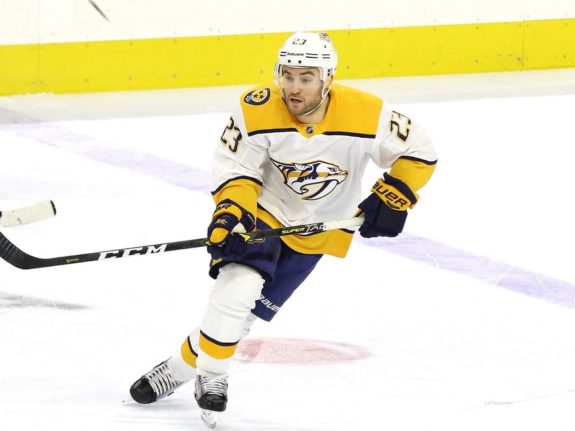
Question(s): With better linemates and a carved-out role, what’s Grimaldi’s ceiling?
Grade: A+ | Grimaldi joined the organization not expecting to play much in the NHL and all he did was serve any role the team needed him to.
Miikka Salomäki
Salomäki only played in 37 games in 2018-19, the result of injuries and being a healthy scratch. His three goals and seven points did result in a career-high in goals-per-game and points-per-game. He was an impactful bottom-six forward when he played and is one of the few Predators who enjoys hitting. It’d be nice to see him produce more, as he’s been disappointing so far in his NHL career considering he posted 50 points in his rookie AHL season.
Question(s): Does he have a role long-term in Nashville given the contract statuses of their forwards and prospects like Eeli Tolvanen and Rem Pitlick pushing for playing time?
Grade: C- | Salomäki didn’t do anything to earn himself extra playing time nor did he stand out from a number of forwards who could be in a fourth-line role.
Brian Boyle
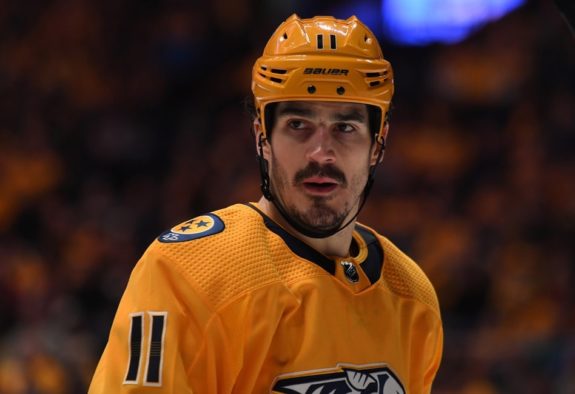
The Predators acquired Boyle from the New Jersey Devils at the trade deadline. Brought in to center the fourth line, bring some size to the lineup and serve a net-front role, Boyle went beyond expectations with five goals, including one on the man advantage, in 26 games. He also added two assists in the playoffs. Combined with what he did before the deadline, he had one of the best seasons of his career. For a team needing more size in the lineup, he was a great fit.
Question(s): An unrestricted free agent this offseason, can the Predators re-sign him? He served his role well, and if they want to get bigger and more physical, which I feel they need, Boyle is a way to add both elements.
Grade: A+ | Boyle only cost a second-round pick and he was one of the Predators’ best forwards post-deadline. He also showed up in the postseason.
Mikael Granlund
I was pretty excited when the Predators acquired Granlund at the deadline. Giving up Kevin Fiala was a big price to pay, but Granlund is a proven player, already with two 60-point seasons to his name. Brought in to bring scoring help to the second line, he didn’t have the immediate impact many expected. In 16 games with the Predators, he only had one goal and four assists.
Part of his low production was due to him shooting 3.4 percent, which will rebound. He did, however, look good pretty much the entire time, nearly always a threat in the offensive zone. Laviolette needed to play him more, and hopefully next season that will be the case. He looked a lot better in the postseason, where he had one goal and one assist in six games.
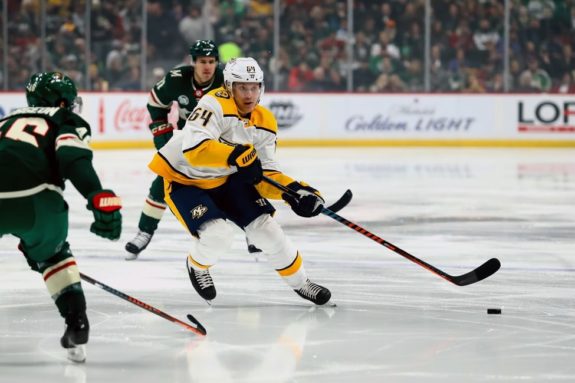
Question(s): If he has someone better than Turris as his center, can Granlund regain his scoring touch?
Grade: B- | Looked better as he got more comfortable in the Predators’ system and gained chemistry with linemates. However, he still didn’t produce as expected.
Frédérik Gaudreau
Another player like Salomäki, Gaudreau is a fourth-line player for the Predators. He scored his first NHL goal this season and ended the campaign with three goals and an assist. He also finished the season with a plus-four turnover margin, but for the most part he was forgettable.
Question(s): Like Salomäki, is there a long-term role with the Predators for Gaudreau? A team can only have so many fourth-liners.
Grade: C | He is a fourth-line role player who had an average season. Nothing about his game stood out, good or bad.
Zac Rinaldo
I didn’t understand why the Predators signed him last season, and still don’t. He only played in 23 regular-season games, as he was a healthy scratch most nights, and didn’t play at all in the postseason. In those 23 games, he had one goal and two assists. He played a much less aggressive style than he has in the past, but he wasn’t an impactful player. He plays in a way that’s largely been done away with and he will likely struggle to find NHL playing time in the future.
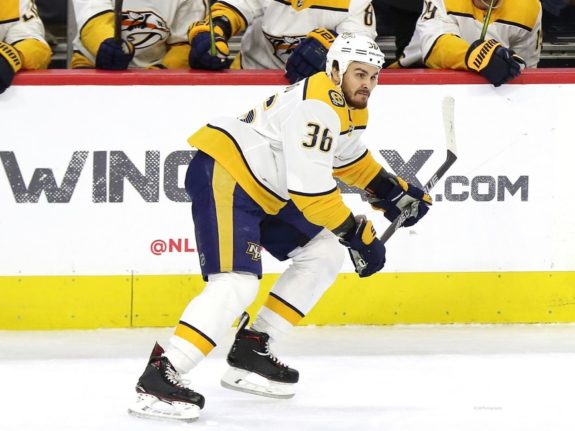
Question(s): Not a question, but Poile should not, in any circumstances, re-sign Rinaldo this offseason. I guess he could play in the AHL, but there are more talented players who deserve the playing time.
Grade: D | He didn’t bring anything positive, but he also didn’t cost the team as much as he could have.
Wayne Simmonds
Another deadline addition, Simmonds was brought in to help the Predators’ struggling power play. Unfortunately, not even Simmonds could fix it, as none of his three points in the regular season occurred on the man advantage. He also went pointless in two playoff games before getting hurt. Looking back, the Predators weren’t a good fit for him. Laviolette only gave him fourth-line minutes, although there was nowhere else for him to play, and the team in general treated him unfairly. He was actually really good in a net-front role, but the team wasn’t designed to take advantage of Simmonds’ skillset.
Question(s): Assuming the Predators don’t re-sign him, and they shouldn’t, which team will show interest in a 31-year-old winger with a lengthy injury history? Furthermore, who do the Predators deploy in a net-front role next season?
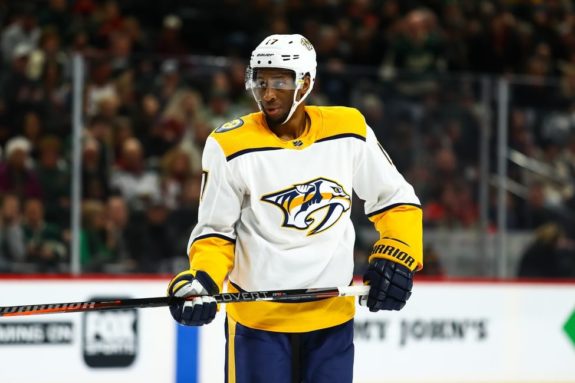
Grade: C | Simmonds may not have produced like many expected, but it wasn’t entirely his fault. The Predators could have put him in a better spot to succeed.
Eeli Tolvanen
The Predators’ top prospect spent the majority of 2018-19 in the AHL, where he had 15 goals and 35 points in 58 games. He also went pointless through five AHL playoff games. He did appear in four NHL games and posted two points, including his first NHL goal. He didn’t look out of place with the Predators, making smart reads and even backchecking.
Considering the team needed scoring all season, it was surprising they didn’t recall him again. Tolvanen showed faith in the organization by not exercising his out clause that would have allowed him to return to the KHL and instead chose to remain with the Milwaukee Admirals and work on his two-way game. He’s no longer solely a goalscorer, but has honed his playmaking abilities and is at home in all three zones, with and without the puck.
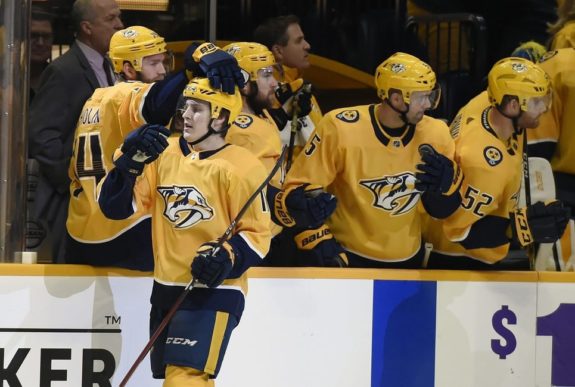
Question(s): Has he done enough to show he belongs in the NHL next season? And if they don’t instead to use him in the NHL, what’s their plan with him?
Grade: B- | Most teams likely would have had Tolvanen on their NHL roster this season, however, the Predators are taking a patient approach with him. He performed well this season and has worked on everything they asked him to.
Overall Thoughts on Predators’ Forwards
The Predators have a lot of forward depth. They also have a strong top line that can be as good as any team’s first unit. However, the team lacked scoring on the bottom three lines all season. Forward depth is great, but it is only so impactful as long it generates offense, and it didn’t in 2018-19. Opponents realized that if they shut down the top line, the Predators’ offense will struggle. That needs to change this offseason. They finally need to address the second-line center spot and add more talent in the top-six in general.